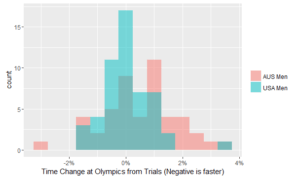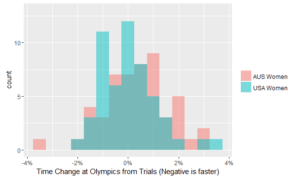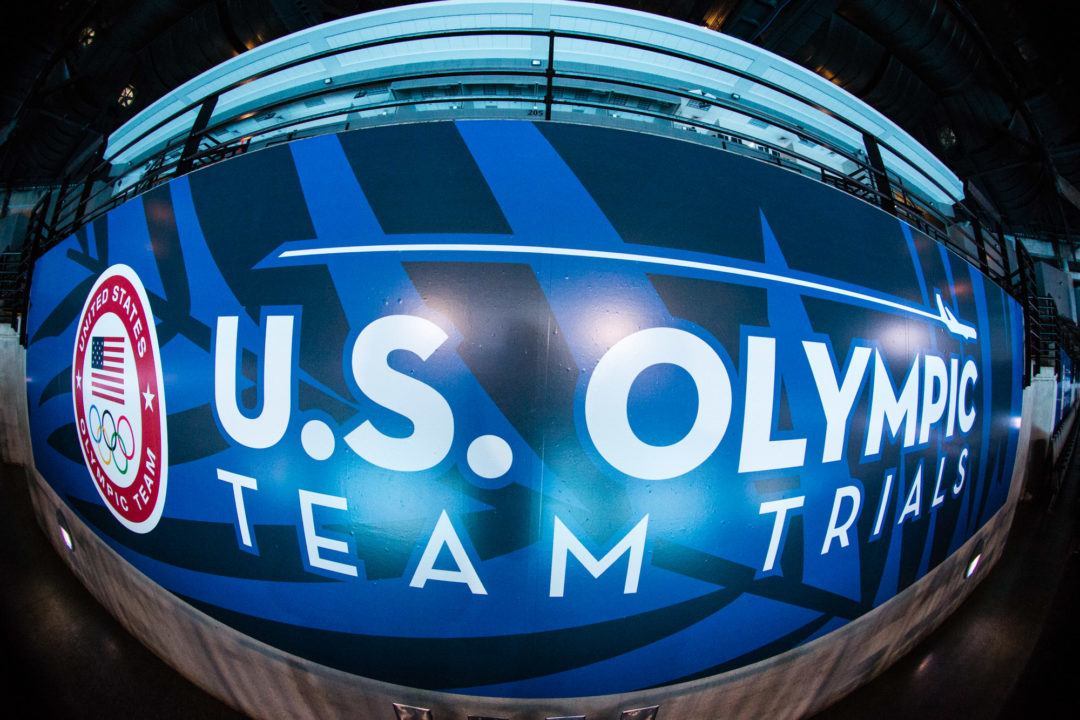The U.S. Olympic Trials are frequently criticized for being much closer to the Olympics than the trials meets of many other countries around the world. Essentially all U.S. swimmers have to full taper for trials to make the Olympic team (maybe not Katie Ledecky). Those who qualify have about a month to re train/taper for the Olympics. The theory goes that this isn’t enough time for swimmers to perform at their absolute best at the Olympics coming off a trials taper. However, there is evidence this isn’t the disadvantage many think it is. In fact the US trials proximity to the Olympics may actually be an advantage.
To test this, I compared the US’s performance at the Olympics vs their Olympic Trials to Australia’s performance at the Olympics vs their Olympic Trials for 2012 and 2004 (skipping 2008 does a couple things. It avoids any issues with the super suits and it gives the sample a more diverse athlete pool. Also I compared best times at each meet regardless of round). Australia is a solid comparison for the US. They have a deep athlete pool that requires their top athletes to rest at trials to guarantee a spot on the team and their Olympic Trials is held in March, 3 months before US Trials.
Relative to their Trials times, US swimmers were better than the Australians at the Olympics. Australian men added a median of .6% to their Trials times. US men’s times had a median change of 0%. Similarly for the women, the Australians added .3% and the US dropped .2%. US swimmer’s were also more consistent than their Australian counterparts, with a lower standard deviation of their time drops (see table below).
US swimmers avoided large time adds more than the Australians. The US men had 1 time add of more than 2% (Jason Lezak 2004, 100 Free) vs 6 for the Australian men. The US women had 2 time adds over 2% (Kate Ziegler 2012 800 free and Katie Hoff 2004 400 IM) vs 5 for the Australian women. The Australians did have a couple of time drops over 3%, but they came in events that were largely uncompetitive for the top swimmers at Trials (Stephanie Rice and Thomas Fraser-Holmes in the 2012 400 IM where Australia only had 2 swimmers under the Olympic A standard at trials for men and women. Rice and Fraser-Holmes were 11 and 6 seconds ahead of 3rd place).
A less competitive Trials meet should lead to star swimmers dropping big time at the Olympics as they don’t have to take qualification as seriously. The fact that there are cases that appear to be exactly this effect padding the Australian numbers and the Australians still add more time than the Americans is reasonably compelling evidence that the US trials date isn’t a disadvantage.
Here are the summary stats of the time changes (positive is slower):
| AUS Women | USA Women | AUS Men | USA Men | |
| Average | 0.4% | 0.0% | 0.5% | 0.0% |
| Median | 0.3% | -0.2% | 0.6% | 0.0% |
| Standard Deviation | 1.3% | 1.1% | 1.3% | 0.8% |
Here’s how the men’s time changes were distributed (52 US men’s times vs 48 for the Australians due in part to this):

Here’s how the women’s time changes were distributed (51 AUS times, 52 US):


The article makes interesting reading but if it were to be a serious analysis there are issues that need to be taken into account and considered.
For instances, Australia is a southern hemisphere nation and the USA a northern hemisphere one.
Right there is a sampling problem as there is no control for performance across time zones and the need for body clock adjustment when travelling internationally to compete at an elite level.
Competitors from Australia are likely to be affected differentially to US competitors so the difference seen in performance between trials and the Olympics cannot safely be assumed to be merely the length of time between trials and the Olympics.
If you were to include data from the… Read more »
My understanding was that it was common for top swimmers not to do a full taper for the trials,
Pointless article. If history has shown us anything, it’s that America has dominated every Olympics in swimming.
Apparently, “D.C.” stands for “Dumb Comment” or, perhaps “Doesn’t Cogitate.”
And your input means what exactly?
Frequently when nations pick their members a year in advance, they do poorly. It has definitely been shown that picking the “hot hand” works better even with the double taper.
Since most swimmers have to deal with a double taper for their conference championships and NCAAs, they can handle it well.
I vote to continue with the current system. If there should be a change, it should be from SCY to LCM. A huge number of our best swimmers are SCY specialists who never get to the Olympics.
Does any other national federation fill all the allowed spots for their teams? Meaning, does any other nation have the full complement of 2 swimmers per event, all relays entered, and allowable relay reserves? Those nations that don’t, but that have had some success over the years know that they have top swimmers in a few events that may medal (Peaty, SMO, Manaudou, Fraser-Holmes, Campbell sisters, French mens relays, Dutch womens relays, Sjostrom, Paltrinieri, Fratus, Hagino, leClos, etc), but not many others. They have their Trials early to solidify the places for the top swimmers, give them a chance to resume training in a national setting (many nations have national teams that are units year-round), then create chances for filling… Read more »
IIRC, this time around only USA has filled in all the top two individual spots.
as far as i can recall the last time the USA held trials early was in March of 1992. Their total medal count was 40 that year with 17 golds. You would have to go back to 1968 and 1972 to get higher counts (52 and 43 for totals, and 21 and 17 golds, respectively). But since 1992 they have still been dominant, with an ever increasing world-wide competition.
If the coaches know what they are doing, having a “double taper” has absolutely no disadvantage and probably an advantage for the swimmer, especially if you believe in USRPT principles. You can easily assume everyone going to Rio for the US has coaches that know what they are doing.
The other big benefit is you get the fastest swimmers today, not whoever was fastest 3-6 months ago. This is especially important for younger swimmers as they could make big improvements over a few months.
It is great to have trials close to the olympic. Best example is how badly USA performed at Kazan last year.